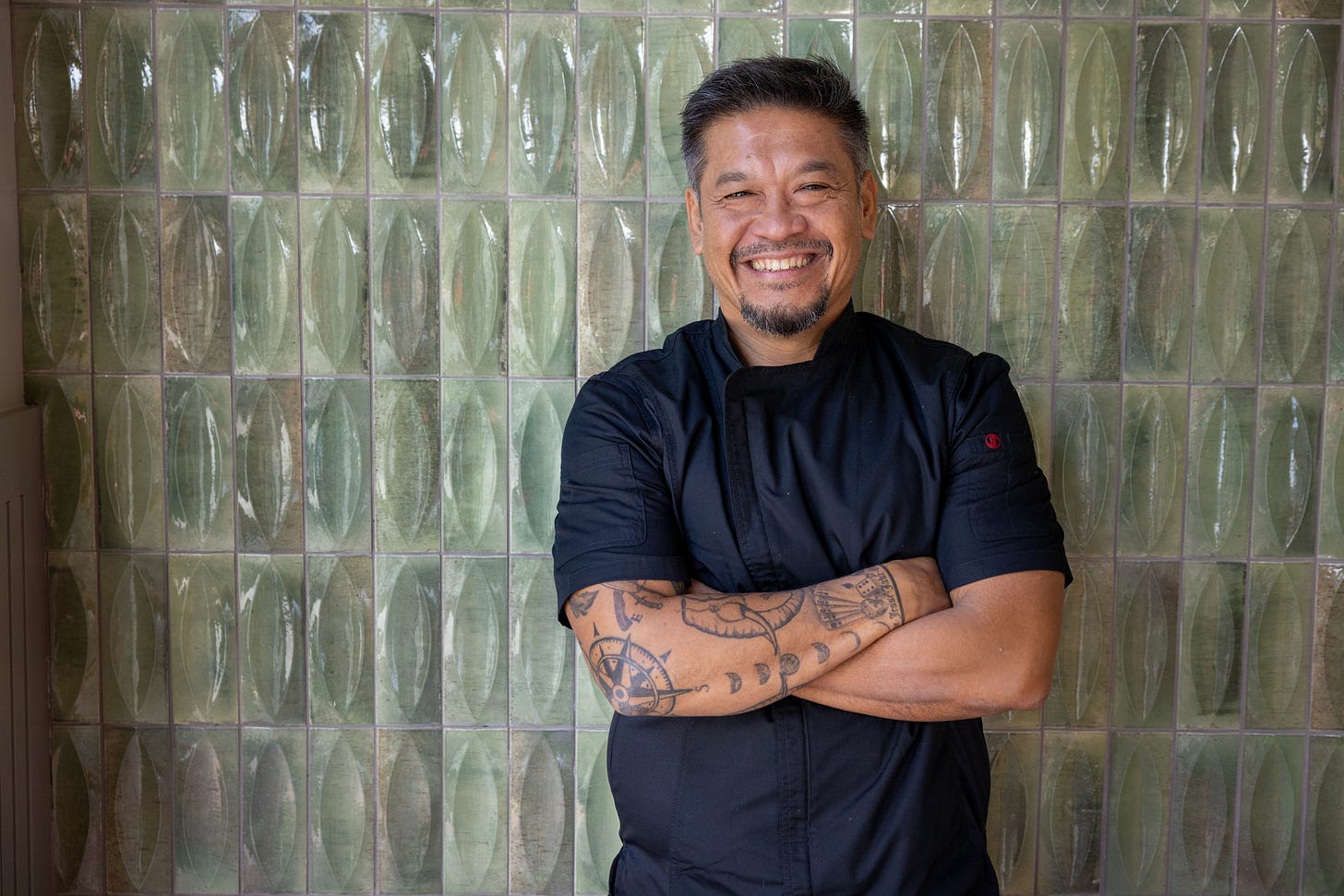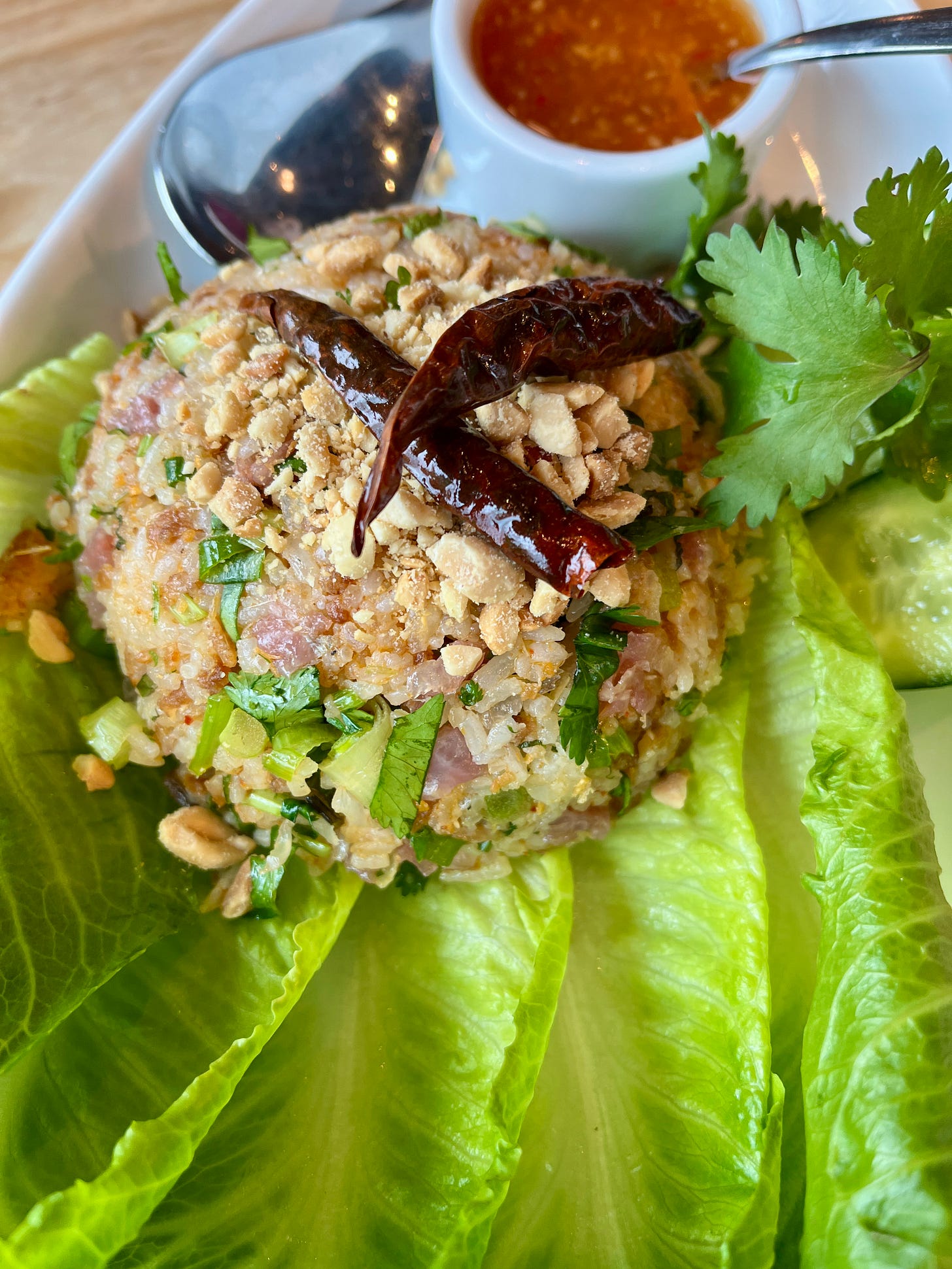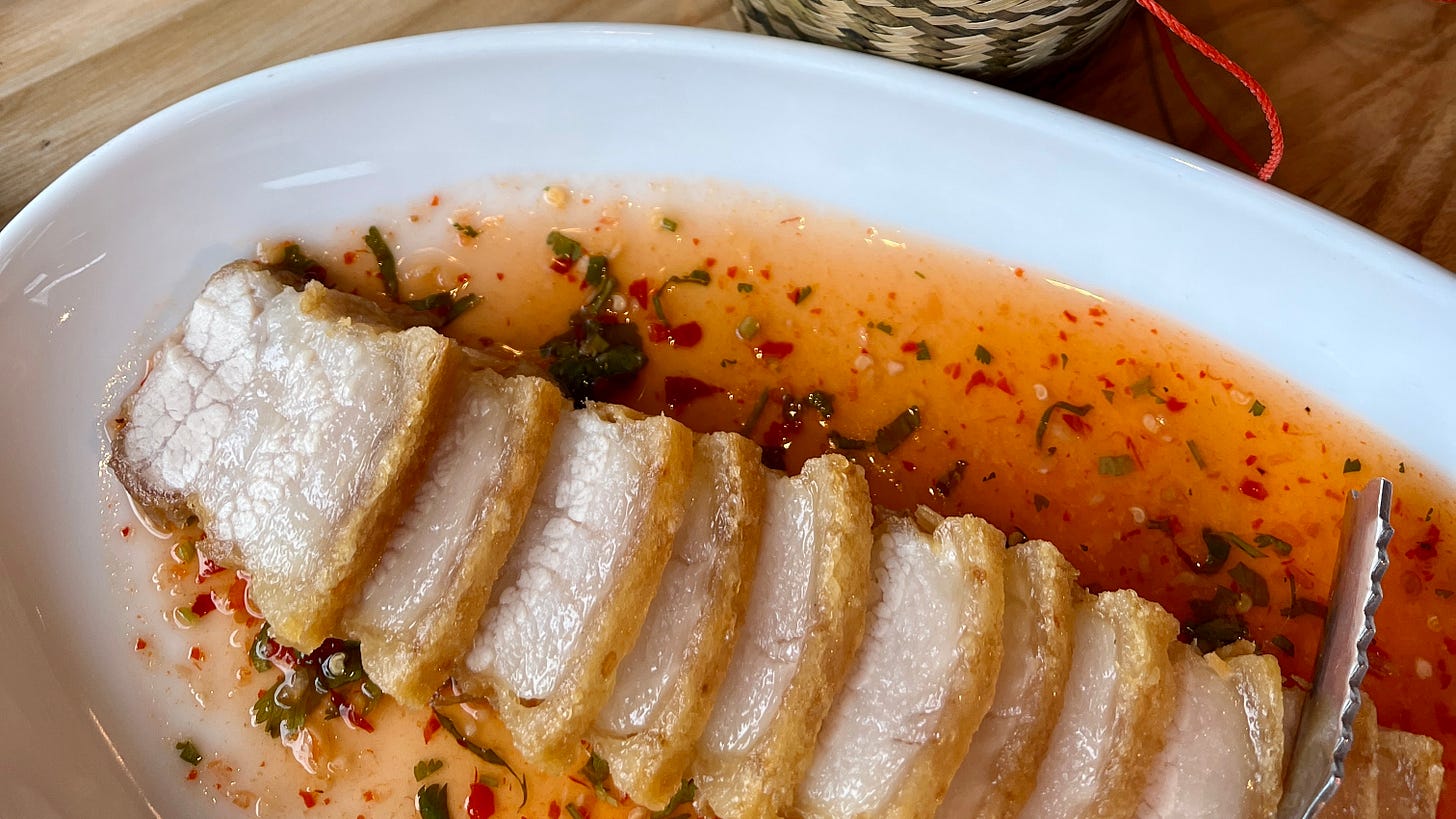Tastes Like Home
Some fragmented thoughts on the Laotian-American chef Lon Bounsanga, his new restaurant SAAP, the taste of comfort, interviews with Edouard Louis and Marilynne Robinson, and the music of Bridgerton
Thursday, March 7
Grand Rapids, Mich.
Growing up in Philadelphia, Lon Bounsanga learned the importance of feeding other people. He didn’t have much choice. “In our culture, usually the oldest daughter would feed the family. I didn’t have the luxury of having a sister,” he told me. When his parents left for work at 6 a.m., they’d leave rice and some eggs for young Lon and his siblings. “We’d eat our breakfast and go to school. Then, when I got home, I’d start more rice, and when my parents got home, I’d help them in the kitchen.”
He didn’t take any of it for granted—not the rice, not the eggs, not the kitchen. Lon was born in Laos. His father was in the Royal Lao Armed Forces; his mom was a farmer. Then the Communists seized control after a long and devastating civil war, and the Bounsangas fled for neighboring Thailand. After two years in a refugee camp there, they immigrated to the United States, thanks largely to a Philadelphia trucking-company owner who sponsored them as refugees and gave Lon’s parents jobs.
After high school, Bounsanga became a cook, gradually working his way up in kitchens in the Philadelphia area. Eventually he married an Irish Catholic girl and had kids. In 2007, they moved from Pennsylvania to North Carolina, mainly because he felt it would be a better place for his children to grow up. He got a job cooking at a country club. Then, one day, he spotted an odd ad on Craiglist: A Laotian restaurant was opening in Raleigh, and it needed a chef.
Bida Manda, owned by the Nolintha siblings and with Bounsanga as its chef, debuted in 2012. It quickly became a fixture on local and regional “best restaurants” lists; in 2016, Business Insider named it the best restaurant in all of North Carolina. The following year, the Nolinthas opened Brewery Bhavana, where Bounsanga also oversaw the menu and kitchen. Bon Appetit named it one of the country’s 10 best new restaurants, and it was shortlisted for a James Beard Award.
The success was gratifying, but only in part. “Even though I was the chef, it was still someone else’s vision,” Bounsanga said. He had his own dream, his own ideas, his own vision.
Last fall, he finally opened his own restaurant, SAAP, in Cary, N.C. In Lao, “saap” means “yummy.”
--
I never order lettuce wraps. Lettuce is fine. I grow it. The frilly, red-leaf varieties can be pretty. In a BLT or a tuna-fish sandwich, lettuce is a textural asset. But if I see “lettuce wraps” on a menu, I’ll always think, There must be something more... interesting.
Then, last month, when I ate at SAAP, Bounsanga sent our table the lettuce wraps. Atop a fan of lettuce leaves sat a glistening half-dome of crispy rice, garnished with herbs and crowned with peanuts as well as two chili peppers. I dutifully scooped some rice onto a lettuce leaf, doused it with some of the accompanying sauce, took a bite, and entered a wonderland of texture and flavor: the deeply savory, crunchy rice; the brightness offered by citrus and herb; meaty bits of mild coconut; the simultaneously sour, sweet, salty, spicy sauce; the crisp lettuce. It was glorious.
The lettuce wraps were an object lesson: Especially when encountering an unfamiliar cuisine, it’s wise to surrender your prejudices, admit your lack of knowledge, and be open.
I didn’t even understand what I was eating until I talked with Bounsanga later. Nam khao, as the dish is known in Lao, has great significance in Lao culture. “We have that dish at every festival,” he told me. “It’s the dish we make for birthdays, the dish we make for anniversaries: That is the dish—a gesture of gestures for a Laotian.”
Part of the significance of the gesture is the immense, patient work that goes into nam khao. Jasmine rice is steamed, then cooled. It’s thoroughly mixed with red-curry paste and left to sit overnight. The next day, it’s formed into a patty, double-fried to create the crisp, broken up, and seasoned with herbs—basil, mint, cilantro—as well as lime juice. “There is no way to rush that dish,” Bounsanga said. If you don’t cool the rice properly, it can get soggy. If you make too big a batch, at too high a temperature, the rice’s heat can turn the herbs a dull brown.
Teaching has been a huge part of Bounsanga’s work as a chef. It’s inevitable when you specialize in a cuisine with which most American diners as well as cooks aren’t intimately familiar. He has painstakingly trained cooks over the years to understand the nuances of the Lao palate. He has also had to work with farmers to get a reliable, high-quality supply of the ingredients he needs. Sourcing good ginger has never been a problem; galangal, kaffir-lime leaves, and even Thai basil and lemongrass have been tougher.
Then there is the diner’s capacity for spice. “Lao cuisine is one of the spiciest in all of Asia, strong both in flavor and in spice level. It’s at least equal to Thai, and I’d even say more than Thai,” Bounsanga said. “Lao people grow their own chilis. You have your own plants at home, and everyone will just pick them and eat them as they’re walking by.”
While he has witnessed a growing openness to different foods over the past decade, “one thing I’ve learned is that people in this community have different palates, and the spice level they prefer is, uh...” He smiled and paused for a moment, searching for the right words. “Very unique.” So he has dialed the spice down. Where a dish flavored to Laotian preferences might call for a tablespoon of chili paste, he’ll put just a teaspoon and offer extra chili sauce on the side. The accommodation is a practical one: “I’d rather have a guest enjoy the dish than return it.”
Bounsanga has drawn a line: There are no non-Laotian dishes on the menu. From the start, Bida Manda has had a pad Thai on the menu as well as a sweet-chili salmon dish, “for guests who are not familiar with the cuisine, but they are familiar with salmon, which is not really known in Laos,” he said. With SAAP, “I am definitely trying to be more authentic.”
Some dishes on SAAP’s menu are undoubtedly reminiscent of those you’d find on the menus of more familiar Asian cuisines, but this is not concession so much as a reflection of the culinary reality: Laos has been heavily influenced by its neighbors—China to the north, Vietnam to the east, and Thailand to the west. But the Laotian dishes are distinct. Pad lao, for instance, also known as khua mee, is a cousin to pad Thai. But pad Lao emphasizes soy, it has neither tamarind nor citrus, and it does have both caramelized onions and shallots, which nod to the many decades of French rule in Laos.
“There’s a lot of French influence for sure,” Bounsanga said. His pork belly, slowly rendered in a pot for hours until golden and caramelized, is a Laotian take on pork confit. It shows up on its own—accompanied by sticky rice and jeow som, a vibrant sauce that’s at once sweet and sour and spicy. You’ll also find it, glistening and resplendent, in Bounsanga’s gorgeous take on mee ka tee, the traditional Laotian pork-belly egg-drop noodle soup that is fragrant with curry and coconut.
--
As I thought about the meal I had at SAAP, the word that kept coming to mind was “home.”
The flavors and textures of Bounsanga’s cooking weren’t necessarily the same as the ones I grew up with or that I now make in my own kitchen. A talented chef, though, can transport you somewhere new while creating that sense of comfort, of a deep and abiding hospitality. To eat Bounsanga’s vegetable curry is to be enfolded in a warm and tender embrace: chunks of kabocha squash, root vegetable, and shiitake mushroom, all bathed in a gentle yellow curry sauce. When you feel welcome, you’re also willing to accept a little surprise. In this dish, it came from Bounsanga’s single nontraditional tweak: a sprinkling of raw enoki mushrooms on the top, which cook just a little in the stew and add a bit of bite.
Not long after SAAP opened, a middle-aged Indian couple came in for a meal. They ordered the whole North Carolina fried fish.
“The fish we use depends on the day—whatever they have from the coast,” Bounsanga told me. Often it’s snapper, sometimes black bass. Bounsanga marinates the fish in fish sauce, lemongrass, and jeow som, a spicy-and-sour condiment made with garlic, chili peppers, lime, and other herbs and spices. Then he dusts the fish with potato starch and deep-fries it until crispy, serving it with papaya salad and sticky rice.
When the fish arrived at the couple’s table, the woman began clapping her hands and stomping her feet. By the end of the meal, little was left but bones. “She was so excited. She said that the fish brought her back to India with her family. It brought back memories of cooking with her mom. Obviously it wasn’t the same, but the flavor profile, the essence of the dish—they brought her back,” Bounsanga told me. “That brought tears to my eyes.”
Though Bounsanga has never been able to return to Laos, he has found a way to create home on the plate, for himself as well as for others. “This is success to me,” he said. This is the fulfillment of a dream—to feed not just bodies but also souls, to kindle old memories and to make some new ones.
SAAP (370 South Walker Street, Cary, N.C.) is open for dinner every night from Tuesday to Sunday; it also serves lunch from Thursday to Sunday.
What I’m Reading: We’re in conversation mode today.
Edouard Louis, whose remarkable genre-straddling books include The End of Eddy, is one of my favorite writers. His latest, Change, has recently been published. Louis mines his own life for each of his books, puzzling over class divisions and prejudices as well as the tortured relationship society has with transformation. This interview, from the Los Angeles Review of Books, is so thoughtful and challenging. I’m still mulling his take on authenticity: “[People] will see authenticity as your childhood, your father, your blah blah, or where you were at 10 years old. But for me, radical authenticity is the authenticity that you build, and you choose, which means you can keep things from your childhood, you can keep things, if you want, from your dad. You can, but you don’t have to. It’s the things that you take and that you build. But that notion of radical authenticity is at war with the society in which we live, which will always try to destroy the people that they consider illegitimate imitators or illegitimate performers or illegitimate becomers, the people becoming something else.”
Another of my favorite writers: Marilynne Robinson, who, in her novels, has so often explored spiritual themes. She now turns to Scripture itself, with the publication of Reading Genesis, which is exactly what the title suggests. She has recently spoken with David Marchese and Ezra Klein, two of the most skillful interviewers working today. (I could devote an entire newsletter to the cheapening of the art of the interview thanks to the proliferation of podcasting. Everyone thinks they know how to interview well. They don’t—but Marchese and Klein do.)
Ignore the terrible headline on the piece by Marchese, who oversees the New York Times Magazine “Talk” column. The conversation he has with Robinson is wide-ranging and lovely, touching on everything from her encounters with Barack Obama to the movie “Barbie” to the goodness of humanity. I even found an unexpected connective thread with the Louis interview: Robinson talks about artists and writers “flying in the face of bourgeois expectation.”
The wisdom continues to flow in Robinson’s chat with Ezra Klein, whose eponymous podcast is also hosted by The New York Times. This interview focuses much more on Scripture, theology, and spirituality. Robinson discusses John Calvin, “whom I love and other people disparage without reading,” and Biblical translation (“part of the idea of the harshness of God is a consequence of the ways that traditional translation have supplied language that is not good language in terms of the text. And this is virtually never what the text is actually telling you.”). Her thoughts on the themes of grace and forgiveness in the Book of Genesis are especially moving. She describes the Biblical scene of Joseph forgiving his brothers thus: “ It’s a very, very beautiful image of grace that I think of having no parallel in ancient literature. To be able to look beyond the offense rather than to forgive the offense, I think, is the difference between grace and simple forgiveness.”
What I’m Listening to: While I finished up the second draft of Good Soil and while Tristan was traveling for a few days, I allowed myself an episode or two of Bridgerton each evening. As those of you who have been reading these letters for a while know, I rarely watch a show when it first comes out, so this was my first experience of Bridgerton. I hadn’t read any reviews. I didn’t really know what it was about. All that mattered to me was Jonathan Bailey. My Lord.
Anyway! Watching Bridgerton was fortuitous in a way that I didn’t expect: It gave me some new background music for my writing. The soundtracks, orchestrated by the pianist and composer Kris Bowers, are so clever and playful. Setting Kate and Anthony’s allemande to an instrumental setting of the Robyn classic “Dancing on My Own”? Genius. “Material Girl” for a quadrille? Amazing. Their last dance to “Wrecking Ball”? Wrecked me.
Bowers’s own compositions are no less moving. I’ve always loved a good film score (some favorites: Henry V and Sense and Sensibility, both by Patrick Doyle; Ad Astra, by Max Richter; and The Theory of Everything, by Johann Johannsson). The Bridgerton score ranks up there with the best. I could just ride the swells and waves of “We Could Form an Attachment” all day long.
What have you been eating lately that gives you delight? Any reading recommendations? Any suggestions to fill my post-Bridgerton void? Anyone want to discuss Bridgerton (or Jonathan Bailey) with me?
Please keep our Fozzie in your thoughts and prayers. Our little buddy is, like so many of us, feeling some of the aches and pains of getting older. He has his good days and he has his bad days. We’re hoping for plenty of spring sunshine, which always seems to cheer him up.
All my best,
Jeff








Thinking of you and Fozzie!
All Creatures Great and Small! (on PBS )
We just finished His Dark Materials - dare I say the series was better than the book? It was so refreshing to my post-evangelical soul.
I love soundtracks too! I just worked on my dissertation to Bridgerton - it’s perfect for writing. I also really like Bear McCreary’s work for Outlander and Rings of Power.